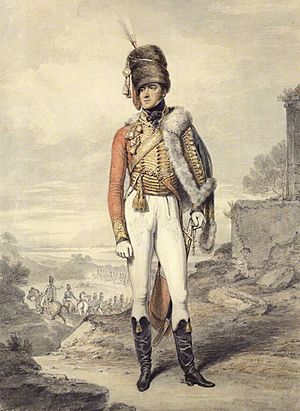Lord Uxbridge's leg facts for kids
Lord Uxbridge's leg was badly hurt during the Battle of Waterloo. It was hit by a cannonball and had to be removed by a surgeon. This leg then became a strange tourist attraction in the village of Waterloo, Belgium, where it was buried.
The Battle of Waterloo
Henry Paget, who was the 2nd Earl of Uxbridge at the time, was a very important commander at the Battle of Waterloo. This famous battle happened on June 18, 1815. Lord Uxbridge was in charge of 13,000 Allied cavalry (soldiers on horseback) and 44 horse artillery guns.
Around 2:30 PM, during a very important part of the battle, he led a huge charge. About 2,000 heavy cavalry soldiers charged to push back the French army. This charge helped stop the French from winning. However, Uxbridge's troops went too far in their chase and were then attacked by French cavalry. For the rest of the battle, Uxbridge led many more charges. He had eight or nine horses shot out from under him!
Near the end of the day, a cannonball hit his right leg. It was so badly damaged that it had to be cut off above the knee. There's a famous story about this moment. Lord Uxbridge was close to the Duke of Wellington when he was hit. Uxbridge supposedly cried out, "By God, sir, I've lost my leg!" Wellington is said to have replied, "By God, sir, so you have!"
Losing a Leg
After being wounded, Lord Uxbridge was taken to a house in the village of Waterloo. This house belonged to a man named M. Hyacinthe Joseph-Marie Paris. There, his leg was removed by Doctor John Hume and two other surgeons.
Lord Uxbridge was known for being very brave and calm. His assistant, Thomas Wildman, said that during the operation, Paget smiled and joked. He said he had been "a beau" (a handsome man) for 47 years and it was time for younger men to have their turn. Another story says his only comment during the surgery was, "The knives appear somewhat blunt."
Another tale says he asked, "Who would not lose a leg for such a victory?" The saw that was used to remove his leg is now kept at the National Army Museum.
Lord Uxbridge was offered money each year because of his injury, but he said no. Just five days after the battle, the Prince Regent (who later became King George IV) gave him a new title. He became the Marquess of Anglesey and was also made a Knight Grand Cross of the Order of the Bath.
A Special Burial Place
M. Paris, the owner of the house where Uxbridge's leg was amputated, asked if he could bury the leg in his garden. He then turned the spot into a special place, almost like a shrine for a valuable item. Visitors would first see the bloody chair where Uxbridge sat during the surgery. Then, they would go into the garden to see the leg's "tombstone."
The tombstone had an inscription that read: "Here lies the Leg of the illustrious and valiant Earl Uxbridge, Lieutenant-General of His Britannic Majesty, Commander in Chief of the English, Belgian and Dutch cavalry, wounded on the 18 June 1815 at the memorable battle of Waterloo, who, by his heroism, assisted in the triumph of the cause of mankind, gloriously decided by the resounding victory of the said day."
Some people were very impressed by this, while others found it a bit strange. Someone even wrote a funny poem on the tombstone:
Here lies the Marquis of Anglesey's limb;
The Devil will have the remainder of him.
The leg became a popular sight for many important people from across Europe, including the King of Prussia. It was a good way for Monsieur Paris and his family to earn money for many years.
In 1878, there was a small problem. Uxbridge's son visited and found that the bones of the leg were not buried. They had been uncovered during a storm. The family of M. Paris refused to send the bones back to England. They even tried to sell them to Uxbridge's family, which made them very angry. The Belgian Minister of Justice had to step in and order the bones to be reburied.
However, the bones were not reburied. They were kept hidden. In 1934, after the last Monsieur Paris died, his wife found them in his study. To avoid another scandal, she burned them in her furnace.
What Happened Next
Lord Uxbridge's family had a history of losing limbs while serving their country. His brother, Major-General Sir Edward Paget, lost his right arm in 1809. His daughter also lost a hand while helping her husband on a battlefield in Spain.
Lord Uxbridge used a special artificial leg that could bend at the knee and ankle. This leg was invented by James Potts and became known as the "Anglesey leg" after his new title. One of these artificial legs is still kept at Plas Newydd in Anglesey. You can also see a part of his hussar trousers from Waterloo there. Other artificial legs are in the Household Cavalry Museum and the Musée de l'Armée in Paris.
Losing his leg did not stop the Marquess of Anglesey's career. He became a field marshal (a very high military rank) and a Knight of the Garter. He also served twice as Lord Lieutenant of Ireland and twice as Master-General of the Ordnance.
An artist named Constantinus Fidelio Coene painted a picture around 1820. It shows an "Imaginary Meeting" between the Duke of Wellington and the Marquess of Anglesey after his leg was removed. This painting is now displayed at Plas Newydd.
In 1961, the 7th Marquess of Anglesey wrote a book about his great-great-grandfather. It was called One-Leg: the life and letters of Henry William Paget, first Marquess of Anglesey.
See also



